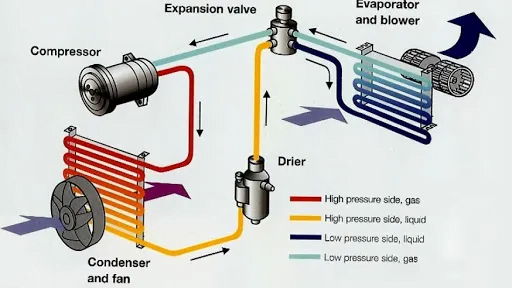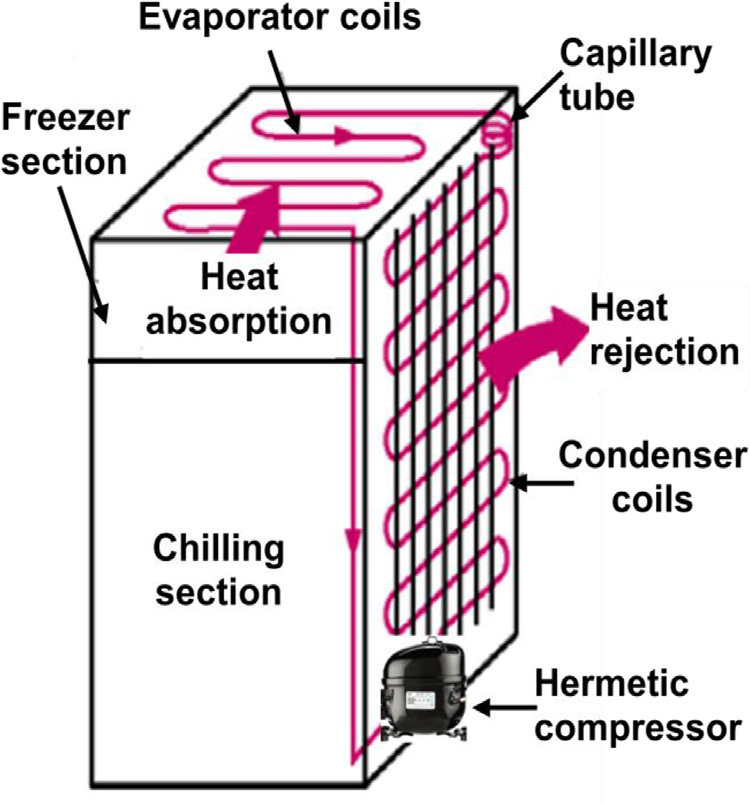Refrigeration is an essential process in our daily lives, helping to preserve food, regulate temperatures, and improve comfort. Understanding the fundamental principles and components of refrigeration can enhance our comprehension of how these systems operate. This blog explores the basic principles of refrigeration, the refrigeration cycle, as well as the principles behind room air conditioners and domestic refrigerators.
Principle of Refrigeration
Mechanical refrigeration systems consist of four primary components:
- Compressor
- Condenser
- Expansion Valve
- Evaporatorr
Compressor
The compressor is often referred to as the "heart" of the refrigeration system. Its main functions include compressing low-pressure gas refrigerant into high-pressure gas refrigerant, which increases its temperature while reducing the pressure in the evaporator. Additionally, the compressor is responsible for keeping the refrigerant moving through the system.
Evaporator
The evaporator is a coil of tubes where heat is absorbed from the refrigerated space. This heat absorption is essential for transferring the heat to the condenser, allowing the cooling process to occur. The evaporator is often known as the freezer, cooling coil, or chilling unit.
Condenser
The condenser is another coil or series of tubes where the heat absorbed in the evaporator is discharged into the atmosphere. Located on the high-pressure side of the system, the condenser plays a crucial role in cooling the refrigerant after it has absorbed heat.
Expansion Valve
The expansion valve is a metering device that controls the flow of refrigerant to the evaporator. It reduces the high-pressure liquid refrigerant to a low-pressure liquid refrigerant in the correct quantities to ensure maximum efficiency and prevent overloading the compressor.
Refrigerant
Refrigerant is a fluid that can easily boil at lower temperatures. It absorbs heat in the evaporator and discharges it in the condenser, making it vital for the refrigeration cycle.
The Refrigeration Cycle
 |
| IMAGE SOURCE |
Evaporator (Point 1): The low-pressure liquid refrigerant moves through the cooling coil, absorbing heat from the foods inside the refrigeration cabinet. As it absorbs heat, it transforms into vapor.
Compressor (Point 2): This low-pressure gas is drawn into the compressor, where it is subjected to high pressure thanks to the compression process performed by the piston unit. Consequently, the refrigerant's pressure and temperature increase.
Condenser (Point 3): The high-pressure gas then passes to the condenser, where it discharges heat and transitions back into a high-pressure liquid.
Expansion Valve (Point 4): Finally, the high-pressure liquid refrigerant passes through the expansion valve, which swiftly reduces its pressure. This decrease in pressure also lowers the temperature of the refrigerant, enabling it to absorb heat again.
Principle of Room Air Conditioner
The working principle behind a window air conditioner is focused on maintaining a constant room temperature of about 25°C. The air in the room is drawn in by a fan and passed over a coiled surface maintained at, for instance, 10°C. As the air cools (to about 15°C), it is blown back into the room.
The refrigerant enters the evaporator at approximately 5°C, where it evaporates while absorbing latent heat from the room air. The vapor is then compressed to raise its pressure before entering the condenser. In the condenser, outdoor air (e.g., at 45°C) is circulated, which absorbs the latent heat from the refrigerant and expels it to the outside environment.
After condensation, the high-pressure refrigerant is reduced to a low pressure through an expansion device, completing the cycle. This same principle applies to larger air conditioning plants, where the condenser is water-cooled instead of air-cooled.
 |
| IMAGE SOURCE |
Principle of Domestic Refrigerator
A domestic refrigerator operates on the same principles as an air conditioner, incorporating the four fundamental components: evaporator, compressor, condenser, and expansion device. However, certain design features are specific to refrigerators.
For instance, the evaporator is located in the freezer compartment, making it the coldest part of the refrigerator, typically at -15°C, while the refrigerant evaporates inside the evaporator tubes at around -25°C. The design includes a chiller tray below the freezer and compartments that progressively increase in temperature.
Cold air, being denser, flows down from the freezer, while warm air rises from the vegetable compartment, establishing a natural convection current that maintains a temperature gradient within the refrigerator.
The condenser's design in a refrigerator differs as well. It is generally a wire tube or plate tube type mounted at the back of the refrigerator, utilizing surrounding air to condense the refrigerant without a fan. The standard condensing temperature is about 55°C.
In modern no-frost refrigerators, the evaporator is positioned outside the freezer compartment, with cold air circulated through forced convection by a fan.
 |
| IMAGE SOURCE |
Understanding the basic components and principles of refrigeration can greatly enhance our appreciation for these systems that keep our food fresh and our living spaces comfortable. Whether it's through mechanical refrigeration in a domestic unit or large-scale air conditioning, the underlying mechanisms remain fundamentally the same, highlighting the incredible efficiency and innovation in thermal management.
References
- "Principles of Refrigeration" by Frank P. Incropera, David P. DeWitt
- "Refrigeration and Air Conditioning Technology" by Bill Whitman, William Johnson, John Tomczyk
- ASHRAE Handbook – Fundamentals
READ MORE: AREA 3 (AB STRUCTURES & ENVIRONMENT ENGINEERING & BIOPROCESS ENGINEERING & ALLIED SUBJECTS)







.png)

0 Comments